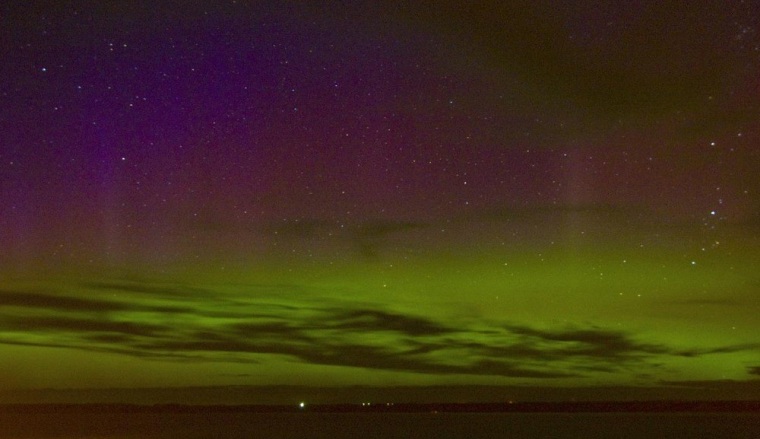Tonight provides the last best viewing opportunity for northern lights created by this week’s amazing outbursts from the sun. But even if you're far south of the aurora zone, don’t take your eyes off the skies: The summer's biggest meteor show is just getting started. The good news for aurora-watchers is that the final waves of solar activity were "dragging their feet" and swept past Earth later than expected, according to the Harvard-Smithsonian Center for Astrophysics. The northern (and southern) lights are sparked when those waves of electrically charged particles, sent out by solar eruptions on Sunday, interact with Earth's magnetic field. "Unlike trains in Japan, these eruptions don't run on a clockwork schedule," said Leon Golub, an astronomer at the center. Magnetometer readings from the National Oceanic and Atmospheric Administration's Space Weather Prediction Center indicate that geomagnetic activity hit a peak around midday and was on the decline. That suggests that tonight's auroral displays won't be as widespread as they were over the past couple of nights, when observers as far south as Iowa and South Dakota could spot the greenish streaks in the sky. Jenna Nagel, a photography intern at the South Dakota Department of Tourism, was one of the lucky ones. "We knew it was there when the streaks came up," she told me today. On Tuesday, Nagel snapped some pictures from a vantage point near Oahe Dam, just north of Pierre on the Missouri River, and dropped one of them into msnbc.com's FirstPerson photo in-box. That image now graces the top of this item. "I didn't even see the pink part [of the aurora] until I saw the pictures," Nagel said. SpaceWeather.com offers three Web pages' worth of photos, taken from locales ranging from Scandinavia and Canada to Michigan, Minnesota, Wisconsin and Iowa. "If one didn't know what they were looking for, they'd never know they were there," photographer Mike Hollingshead wrote in a message from Little Sioux, Iowa. "With a camera, it makes it easy to be sure." The best strategy for aurora-watching is to get as far away from city lights as possible, with clear open skies to the north. Watch patiently for shifting shafts of light. Auroral displays can glow a faint red or an eerie green - the effect is much subtler than some of the photos make it out to be. The prime time for viewing is generally between midnight and dawn, but auroras are notoriously unpredictable. The glow can last for just a couple of minutes. or go on for hours. If you're far south of the equator, similar instructions apply, except that you'd be looking south instead of north. Australian researcher Tom Luttrell sent SpaceWeather.com some lovely shots of the southern lights as seen from Antarctica's Casey Base. Back in June, space station astronaut Doug Wheelock sent down a beautiful image of the southern lights over Antarctica, but this week the preparations for an emergency repair spacewalk have forced him to scale back on his Earth-gazing time. Based on forecasts from the Space Weather Prediction Center and the University of Alaska's Geophysical Institute, it looks as if the excitement over the northern lights will die down on Friday. But the excitement over the Perseid meteor shower, one of the year's best-known sky shows, is building up even as we speak. The Perseids are due to reach their peak next Thursday night, with a planetary triple play as the warmup act. But all that is another story. We'll tell you more about the Perseids on Friday. Be sure to check out our dazzling slideshow of aurora imagery. Join the Cosmic Log corps by signing up as my Facebook friend or hooking up on Twitter. And if you really want to be friendly, ask me about "The Case for Pluto."
Last hurrah for northern lights?
